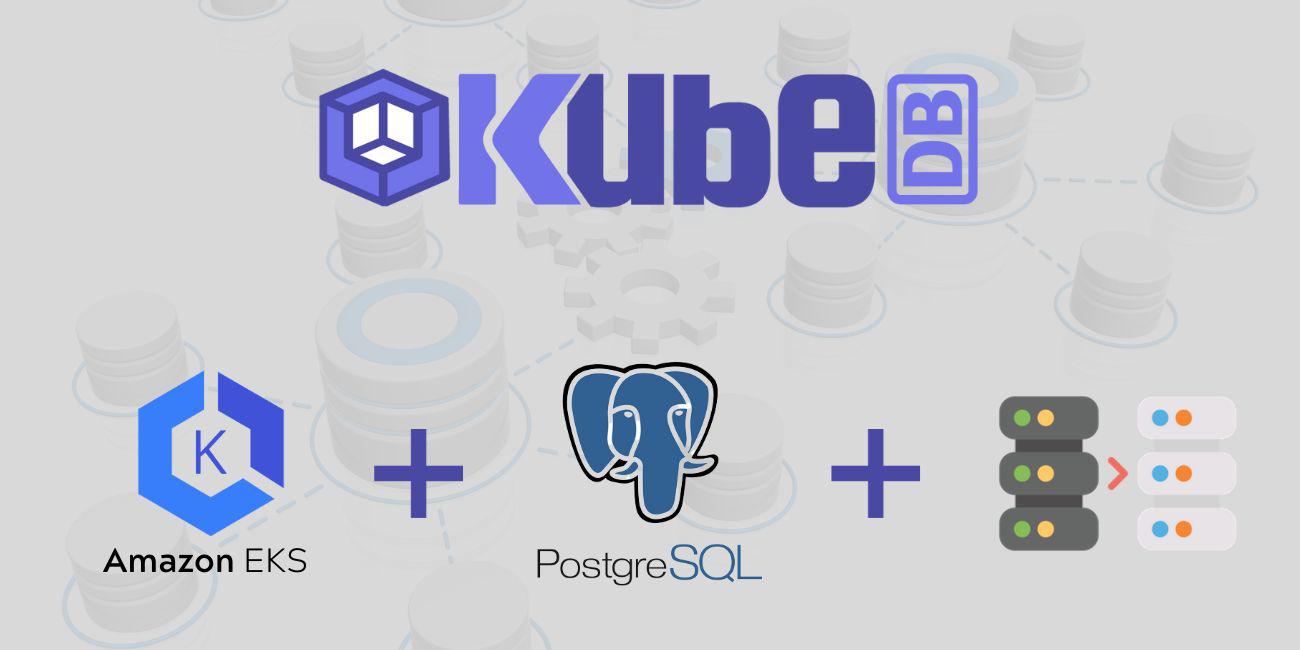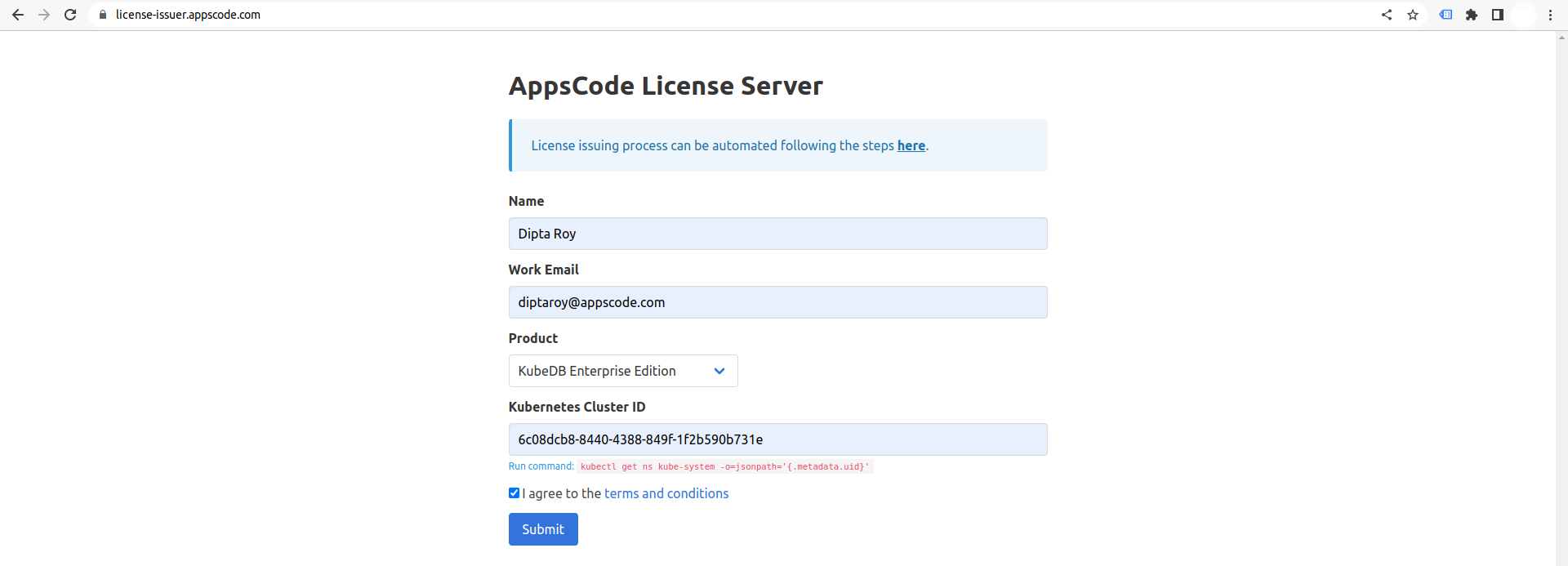
Overview
KubeDB is the Kubernetes Native Database Management Solution which simplifies and automates routine database tasks such as Provisioning, Monitoring, Upgrading, Patching, Scaling, Volume Expansion, Backup, Recovery, Failure detection, and Repair for various popular databases on private and public clouds. The databases that KubeDB supports are Redis, PostgreSQL, MySQL, MongoDB, MariaDB, Elasticsearch, ProxySQL, Percona XtraDB, Memcached and PgBouncer. You can find the guides to all the supported databases in KubeDB . In this tutorial we will update version of PostgreSQL Database in Amazon Elastic Kubernetes Service (Amazon EKS). We will cover the following steps:
- Install KubeDB
- Deploy PostgreSQL Cluster
- Insert Sample Data
- Update PostgreSQL Database Version
Get Cluster ID
We need the cluster ID to get the KubeDB License. To get cluster ID we can run the following command:
$ kubectl get ns kube-system -o jsonpath='{.metadata.uid}'
6c08dcb8-8440-4388-849f-1f2b590b731e
Get License
Go to Appscode License Server to get the license.txt file. For this tutorial, we will use KubeDB Enterprise Edition.

Install KubeDB
We will use helm to install KubeDB. Please install helm here
if it is not already installed.
Now, let’s install KubeDB.
$ helm repo add appscode https://charts.appscode.com/stable/
$ helm repo update
$ helm search repo appscode/kubedb
NAME CHART VERSION APP VERSION DESCRIPTION
appscode/kubedb v2023.10.9 v2023.10.9 KubeDB by AppsCode - Production ready databases...
appscode/kubedb-autoscaler v0.21.0 v0.21.0 KubeDB Autoscaler by AppsCode - Autoscale KubeD...
appscode/kubedb-catalog v2023.10.9 v2023.10.9 KubeDB Catalog by AppsCode - Catalog for databa...
appscode/kubedb-community v0.24.2 v0.24.2 KubeDB Community by AppsCode - Community featur...
appscode/kubedb-crds v2023.10.9 v2023.10.9 KubeDB Custom Resource Definitions
appscode/kubedb-dashboard v0.12.0 v0.12.0 KubeDB Dashboard by AppsCode
appscode/kubedb-enterprise v0.11.2 v0.11.2 KubeDB Enterprise by AppsCode - Enterprise feat...
appscode/kubedb-grafana-dashboards v2023.10.9 v2023.10.9 A Helm chart for kubedb-grafana-dashboards by A...
appscode/kubedb-metrics v2023.10.9 v2023.10.9 KubeDB State Metrics
appscode/kubedb-one v2023.10.9 v2023.10.9 KubeDB and Stash by AppsCode - Production ready...
appscode/kubedb-ops-manager v0.23.0 v0.23.2 KubeDB Ops Manager by AppsCode - Enterprise fea...
appscode/kubedb-opscenter v2023.10.9 v2023.10.9 KubeDB Opscenter by AppsCode
appscode/kubedb-provisioner v0.36.0 v0.36.2 KubeDB Provisioner by AppsCode - Community feat...
appscode/kubedb-schema-manager v0.12.0 v0.12.0 KubeDB Schema Manager by AppsCode
appscode/kubedb-ui v2023.10.18 0.4.6 A Helm chart for Kubernetes
appscode/kubedb-ui-server v2021.12.21 v2021.12.21 A Helm chart for kubedb-ui-server by AppsCode
appscode/kubedb-webhook-server v0.12.0 v0.12.0 KubeDB Webhook Server by AppsCode
# Install KubeDB Enterprise operator chart
$ helm install kubedb appscode/kubedb \
--version v2023.10.9 \
--namespace kubedb --create-namespace \
--set kubedb-provisioner.enabled=true \
--set kubedb-ops-manager.enabled=true \
--set kubedb-autoscaler.enabled=true \
--set kubedb-dashboard.enabled=true \
--set kubedb-schema-manager.enabled=true \
--set-file global.license=/path/to/the/license.txt
Let’s verify the installation:
$ watch kubectl get pods --all-namespaces -l "app.kubernetes.io/instance=kubedb"
NAMESPACE NAME READY STATUS RESTARTS AGE
kubedb kubedb-kubedb-autoscaler-6974fb8dc4-wgsh8 1/1 Running 0 2m52s
kubedb kubedb-kubedb-dashboard-658f7ddb67-bvkxf 1/1 Running 0 2m52s
kubedb kubedb-kubedb-ops-manager-7b4d9cdcc9-sphxj 1/1 Running 0 2m52s
kubedb kubedb-kubedb-provisioner-594fbf5dd-ls6hq 1/1 Running 0 2m52s
kubedb kubedb-kubedb-schema-manager-654bf5dbb5-sbgdb 1/1 Running 0 2m52s
kubedb kubedb-kubedb-webhook-server-845949b9-k9nlx 1/1 Running 0 2m52s
We can list the CRD Groups that have been registered by the operator by running the following command:
$ kubectl get crd -l app.kubernetes.io/name=kubedb
NAME CREATED AT
elasticsearchautoscalers.autoscaling.kubedb.com 2023-10-27T09:29:25Z
elasticsearchdashboards.dashboard.kubedb.com 2023-10-27T09:27:23Z
elasticsearches.kubedb.com 2023-10-27T09:27:23Z
elasticsearchopsrequests.ops.kubedb.com 2023-10-27T09:28:30Z
elasticsearchversions.catalog.kubedb.com 2023-10-27T09:26:54Z
etcds.kubedb.com 2023-10-27T09:29:08Z
etcdversions.catalog.kubedb.com 2023-10-27T09:26:54Z
kafkaopsrequests.ops.kubedb.com 2023-10-27T09:29:03Z
kafkas.kubedb.com 2023-10-27T09:29:03Z
kafkaversions.catalog.kubedb.com 2023-10-27T09:26:54Z
mariadbautoscalers.autoscaling.kubedb.com 2023-10-27T09:29:25Z
mariadbdatabases.schema.kubedb.com 2023-10-27T09:27:38Z
mariadbopsrequests.ops.kubedb.com 2023-10-27T09:28:44Z
mariadbs.kubedb.com 2023-10-27T09:27:38Z
mariadbversions.catalog.kubedb.com 2023-10-27T09:26:54Z
memcacheds.kubedb.com 2023-10-27T09:29:08Z
memcachedversions.catalog.kubedb.com 2023-10-27T09:26:54Z
mongodbautoscalers.autoscaling.kubedb.com 2023-10-27T09:29:25Z
mongodbdatabases.schema.kubedb.com 2023-10-27T09:27:38Z
mongodbopsrequests.ops.kubedb.com 2023-10-27T09:28:34Z
mongodbs.kubedb.com 2023-10-27T09:27:38Z
mongodbversions.catalog.kubedb.com 2023-10-27T09:26:54Z
mysqlautoscalers.autoscaling.kubedb.com 2023-10-27T09:29:25Z
mysqldatabases.schema.kubedb.com 2023-10-27T09:27:37Z
mysqlopsrequests.ops.kubedb.com 2023-10-27T09:28:40Z
mysqls.kubedb.com 2023-10-27T09:27:37Z
mysqlversions.catalog.kubedb.com 2023-10-27T09:26:55Z
perconaxtradbautoscalers.autoscaling.kubedb.com 2023-10-27T09:29:25Z
perconaxtradbopsrequests.ops.kubedb.com 2023-10-27T09:28:56Z
perconaxtradbs.kubedb.com 2023-10-27T09:28:56Z
perconaxtradbversions.catalog.kubedb.com 2023-10-27T09:26:55Z
pgbouncers.kubedb.com 2023-10-27T09:28:37Z
pgbouncerversions.catalog.kubedb.com 2023-10-27T09:26:55Z
postgresautoscalers.autoscaling.kubedb.com 2023-10-27T09:29:25Z
postgresdatabases.schema.kubedb.com 2023-10-27T09:27:38Z
postgreses.kubedb.com 2023-10-27T09:27:38Z
postgresopsrequests.ops.kubedb.com 2023-10-27T09:28:50Z
postgresversions.catalog.kubedb.com 2023-10-27T09:26:55Z
proxysqlautoscalers.autoscaling.kubedb.com 2023-10-27T09:29:25Z
proxysqlopsrequests.ops.kubedb.com 2023-10-27T09:28:53Z
proxysqls.kubedb.com 2023-10-27T09:28:53Z
proxysqlversions.catalog.kubedb.com 2023-10-27T09:26:55Z
publishers.postgres.kubedb.com 2023-10-27T09:29:06Z
redisautoscalers.autoscaling.kubedb.com 2023-10-27T09:29:25Z
redises.kubedb.com 2023-10-27T09:28:47Z
redisopsrequests.ops.kubedb.com 2023-10-27T09:28:47Z
redissentinelautoscalers.autoscaling.kubedb.com 2023-10-27T09:29:25Z
redissentinelopsrequests.ops.kubedb.com 2023-10-27T09:28:59Z
redissentinels.kubedb.com 2023-10-27T09:28:59Z
redisversions.catalog.kubedb.com 2023-10-27T09:26:55Z
subscribers.postgres.kubedb.com 2023-10-27T09:29:09Z
Deploy PostgreSQL Cluster
Now we are going to deploy PostgreSQL cluster using KubeDB. First, let’s create a Namespace in which we will deploy the database.
$ kubectl create namespace demo
namespace/demo created
Here is the yaml of the PostgreSQL we are going to use:
apiVersion: kubedb.com/v1alpha2
kind: Postgres
metadata:
name: postgres-cluster
namespace: demo
spec:
version: "14.1"
replicas: 3
standbyMode: Hot
storageType: Durable
storage:
storageClassName: "gp2"
accessModes:
- ReadWriteOnce
resources:
requests:
storage: 1Gi
terminationPolicy: WipeOut
Let’s save this yaml configuration into postgres-cluster.yaml
Then create the above PostgreSQL CRD
$ kubectl create -f postgres-cluster.yaml
postgres.kubedb.com/postgres-cluster created
In this yaml,
spec.versionfield specifies the version of PostgreSQL. Here, we are using PostgreSQLversion 14.1. You can list the KubeDB supported versions of PostgreSQL by running$ kubectl get postgresversionscommand.spec.standbyis an optional field that specifies the standby modehotorwarmto use for standby replicas. Inhotstandby mode, standby replicas can accept connection and run read-only queries. Inwarmstandby mode, standby replicas can’t accept connection and only used for replication purpose.- Another field to notice is the
spec.storageTypefield. This can beDurableorEphemeraldepending on the requirements of the database to be persistent or not. spec.terminationPolicyfield is Wipeout means that the database will be deleted without restrictions. It can also be “Halt”, “Delete” and “DoNotTerminate”. Learn More about Termination Policy .
Once these are handled correctly and the PostgreSQL object is deployed, you will see that the following are created:
$ kubectl get all -n demo
NAME READY STATUS RESTARTS AGE
pod/postgres-cluster-0 2/2 Running 0 2m25s
pod/postgres-cluster-1 2/2 Running 0 2m4s
pod/postgres-cluster-2 2/2 Running 0 61s
NAME TYPE CLUSTER-IP EXTERNAL-IP PORT(S) AGE
service/postgres-cluster ClusterIP 10.100.248.168 <none> 5432/TCP,2379/TCP 2m30s
service/postgres-cluster-pods ClusterIP None <none> 5432/TCP,2380/TCP,2379/TCP 2m30s
service/postgres-cluster-standby ClusterIP 10.100.106.115 <none> 5432/TCP 2m30s
NAME READY AGE
statefulset.apps/postgres-cluster 3/3 3m32s
NAME TYPE VERSION AGE
appbinding.appcatalog.appscode.com/postgres-cluster kubedb.com/postgres 14.1 2m36s
NAME VERSION STATUS AGE
postgres.kubedb.com/postgres-cluster 14.1 Ready 2m59s
Let’s check if the database is ready to use,
$ kubectl get pg -n demo postgres-cluster
NAME VERSION STATUS AGE
postgres-cluster 14.1 Ready 4m
We have successfully deployed PostgreSQL in AWS. Now we can exec into the container to use the database.
Accessing Database Through CLI
To access the database through CLI, we have to get the credentials to access. KubeDB will create Secret and Service for the database postgres-cluster that we have deployed. Let’s check them using the following commands,
$ kubectl get secret -n demo -l=app.kubernetes.io/instance=postgres-cluster
NAME TYPE DATA AGE
postgres-cluster-auth kubernetes.io/basic-auth 2 4m34s
$ kubectl get service -n demo -l=app.kubernetes.io/instance=postgres-cluster
NAME TYPE CLUSTER-IP EXTERNAL-IP PORT(S) AGE
postgres-cluster ClusterIP 10.100.248.168 <none> 5432/TCP,2379/TCP 4m57s
postgres-cluster-pods ClusterIP None <none> 5432/TCP,2380/TCP,2379/TCP 4m57s
postgres-cluster-standby ClusterIP 10.100.106.115 <none> 5432/TCP 4m57s
Now, we are going to use postgres-cluster-auth to get the credentials.
$ kubectl get secrets -n demo postgres-cluster-auth -o jsonpath='{.data.username}' | base64 -d
postgres
$ kubectl get secrets -n demo postgres-cluster-auth -o jsonpath='{.data.password}' | base64 -d
zeLSv;mqqlgr1jOD
Insert Sample Data
In this section, we are going to login into our PostgreSQL pod and insert some sample data.
$ kubectl exec -it postgres-cluster-0 -n demo -c postgres -- bash
postgres-cluster-0:/$ psql -d "user=postgres password=zeLSv;mqqlgr1jOD"
psql (14.1)
Type "help" for help.
postgres=# \l
List of databases
Name | Owner | Encoding | Collate | Ctype | ICU Locale | Locale Provider | Access privileges
---------------+----------+----------+------------+------------+------------+-----------------+-----------------------
kubedb_system | postgres | UTF8 | en_US.utf8 | en_US.utf8 | | libc |
postgres | postgres | UTF8 | en_US.utf8 | en_US.utf8 | | libc |
template0 | postgres | UTF8 | en_US.utf8 | en_US.utf8 | | libc | =c/postgres +
| | | | | | | postgres=CTc/postgres
template1 | postgres | UTF8 | en_US.utf8 | en_US.utf8 | | libc | =c/postgres +
| | | | | | | postgres=CTc/postgres
(4 rows)
postgres=# CREATE DATABASE music;
CREATE DATABASE
postgres=# \l
List of databases
Name | Owner | Encoding | Collate | Ctype | ICU Locale | Locale Provider | Access privileges
---------------+----------+----------+------------+------------+------------+-----------------+-----------------------
kubedb_system | postgres | UTF8 | en_US.utf8 | en_US.utf8 | | libc |
music | postgres | UTF8 | en_US.utf8 | en_US.utf8 | | libc |
postgres | postgres | UTF8 | en_US.utf8 | en_US.utf8 | | libc |
template0 | postgres | UTF8 | en_US.utf8 | en_US.utf8 | | libc | =c/postgres +
| | | | | | | postgres=CTc/postgres
template1 | postgres | UTF8 | en_US.utf8 | en_US.utf8 | | libc | =c/postgres +
| | | | | | | postgres=CTc/postgres
(5 rows)
postgres=# \c music
You are now connected to database "music" as user "postgres".
music=# CREATE TABLE artist (name VARCHAR(50) NOT NULL, song VARCHAR(50) NOT NULL);
CREATE TABLE
music=# INSERT INTO artist (name, song) VALUES('John Denver', 'Country Roads');
INSERT 0 1
music=# SELECT * FROM artist;
name | song
--------------+----------------
John Denver | Country Roads
(1 row)
music=# \q
postgres-cluster-0:/$ exit
exit
We’ve successfully inserted some sample data to our database. More information about Run & Manage PostgreSQL on Kubernetes can be found in PostgreSQL Kubernetes
Update PostgreSQL Database Version
In this section, we will update our PostgreSQL version from 14.1 to the latest version 14.8. Let’s check the current version,
$ kubectl get postgres -n demo postgres-cluster -o=jsonpath='{.spec.version}{"\n"}'
14.1
Create PostgresOpsRequest
In order to update the version of PostgreSQL cluster, we have to create a PostgresOpsRequest CR with your desired version that is supported by KubeDB. Below is the YAML of the PostgresOpsRequest CR that we are going to create,
apiVersion: ops.kubedb.com/v1alpha1
kind: PostgresOpsRequest
metadata:
name: update-version
namespace: demo
spec:
type: UpdateVersion
updateVersion:
targetVersion: "14.8"
databaseRef:
name: postgres-cluster
Let’s save this yaml configuration into update-version.yaml and apply it,
$ kubectl apply -f update-version.yaml
postgresopsrequest.ops.kubedb.com/update-version created
In this yaml,
spec.databaseRef.namespecifies that we are performing operation onpostgres-clusterPostgreSQL database.spec.typespecifies that we are going to performUpdateVersionon our database.spec.updateVersion.targetVersionspecifies the expected version of the database14.8.
Verify the Updated PostgreSQL Version
KubeDB Enterprise operator will update the image of PostgreSQL object and related StatefulSets and Pods.
Let’s wait for PostgresOpsRequest to be Successful. Run the following command to check PostgresOpsRequest CR,
$ kubectl get postgresopsrequest -n demo
NAME TYPE STATUS AGE
update-version UpdateVersion Successful 2m48s
We can see from the above output that the PostgresOpsRequest has succeeded.
Now, we are going to verify whether the PostgreSQL and the related StatefulSets their Pods have the new version image. Let’s verify it by following command,
$ kubectl get postgres -n demo postgres-cluster -o=jsonpath='{.spec.version}{"\n"}'
14.8
You can see from above, our PostgreSQL database has been updated with the new version
14.8. So, the database update process is successfully completed.
If you want to learn more about Production-Grade PostgreSQL you can have a look into that playlist below:
Support
To speak with us, please leave a message on our website .
To receive product announcements, follow us on Twitter .
To watch tutorials of various Production-Grade Kubernetes Tools Subscribe our YouTube channel.
More about PostgreSQL in Kubernetes
If you have found a bug with KubeDB or want to request for new features, please file an issue .









